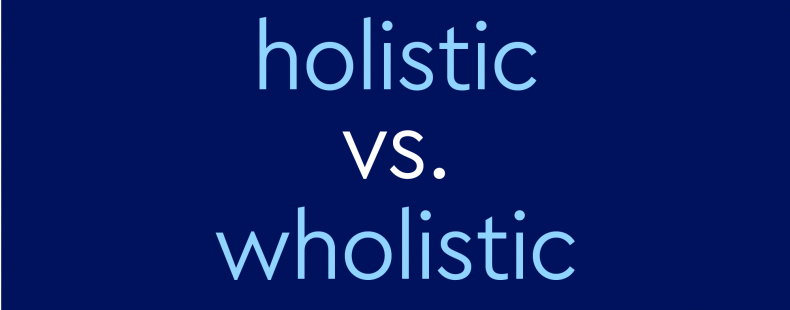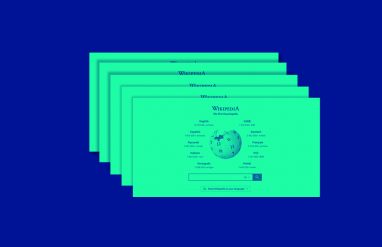You’ve probably come across the word holistic before. It floats around in yoga retreats and meditation studios, spas, healing centers, and health food stores. Predominantly, but not exclusively. Do you spell it with a W? And when you realized it is normally spelled holistic, did you wonder why it’s not wholistic when it’s clearly about the “whole”?
We’ve wondered, too. After all, wholistic would seem a more sensible choice. Right? (Well, in short, Greek is why. But, hang on, we’ll get to that in a minute.)
So, do holistic and wholistic mean the same thing? Can you use them interchangeably? And is wholistic even a word, by the way?
To all of the above, yes. Though many would argue with that. Let’s get into it.
What does holistic mean?
First off, despite its deceiving spelling, the adjective holistic has nothing to do with holes. Not in the slightest. On the contrary, it describes an all-embracing approach that views every aspect of a matter as a cohesive whole rather than a collection of isolated entities. It refers to a mind frame that focuses on the big picture, or the “grand scheme of things,” instead of getting too caught up in the details.
To put it another way, holistic is about looking at the trees without losing sight of the forest. It’s about seeing the forest and the trees and how they relate to each other.
The word holistic comes from holism, a relatively young term, introduced by South African statesman, politician, and philosopher General Jan Christian Smuts. In his 1926 treatise “Holism and Evolution” he defined Holism as “the tendency of nature to form wholes—or organisms, and systems—from the ordered grouping of single units—alias molecules, atoms, and subatomic particles.”
Simply put, Smuts thought of the universe in terms of “wholes,” unceasingly interacting with each other, blending, and merging into even greater “wholes” in perennial motion. To him, holism was the evolutionary drive at the core of all creation.
To name his complex “Theory of the Whole,” he coined holism from the Greek hólos, meaning “whole.” And that’s the only reason behind that W-less spelling that might have left you baffled. The idea of wholeness was pivotal to his theory as it is to anything “holistic.” It echoed the Aristotelian notion “the whole is greater than the sum of its parts” which also underpinned the 20th century revolutionary Gestalt psychology and is often used, these days, to explain synergy.
Shortly after, Smuts’ philosophy was modified, expounded upon, and quickly adopted into other fields, including the medical field among others. Here, it sparked quite a controversial debate and a still ongoing shift in focus, embraced primarily by so-called non-mainstream medicine: from effect to cause, from “signs and symptoms” to “whole individual,” from disease-centered to person-centered care. Today, a holistic treatment might encompass Western medication and procedures, complementary therapy such as massage, and education on lifestyle changes for the patient. Essentially, the focus is on the patient’s overall wellness and not just one disease.
But would a wholistic treatment be much different from a holistic one? Presumably not.
What does wholistic mean, then?
The term wholistic made its first appearance around the 1930s. Wholistic developed as a variant of holistic. The variant likely arose from the fact that, not only is a wholistic a homophone of holistic, but the meaning (and root) of holistic is, as we’ve seen, concerned with “wholes.”
But the English word whole does not come from the Greek hólos; whole ultimately derives from the Old English hāl (“sound, uninjured”). That Old English word is also related to words like health, heal, hale, and hoy. It’s a coincidence that hol- and whole sound and mean the same.
How about Holi? Check out our article that’s bursting with information about this colorful Hind.
When used, wholistic too is firmly anchored in the concept that “the whole is greater than the sum of its parts.” Like holistic, it’s used to describe an all-inclusive approach that looks at all aspects of a subject as interwoven elements of one broader, synergistic entity. Even so, many dictionaries still may not list it as an acceptable variant spelling. And yet, despite not being academically recognized, wholistic is not necessarily wrong.
How do you use holistic vs. wholistic?
Yes, holistic and wholistic can be used interchangeably. As you surely noticed, they look slightly different but sound exactly the same. Ergo, if you are talking about your last aromatherapy session, you might not give it much thought and do just fine. But if you’re writing about it, you might want to ponder on which word to use a bit longer.
As a general rule, drop the W more often than not. Of the two, holistic is considered the standard spelling and is used much more frequently, even more so in academic and medical writing. Here are some examples of how you might use holistic:
- The school’s holistic approach emphasizes meeting each learner’s unique needs.
- I didn’t feel healthy until I tried holistic healing and embraced a variety of treatments.
- The scientist cautioned that a holistic approach to combating climate change will be required.
However, this doesn’t mean you should refrain from using wholistic at all costs, especially if it serves your purpose. Having “whole” as a base, wholistic proves quite handy when you want to emphasize the entirety or wholeness of something.
But your spell checker probably won’t give you a break until you give in, raise the white flag, and swap wholistic for holistic.














